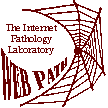|
A 67-year-old man is a resident in an assisted-living retirement community. He has been in generally good health during the past few years, with only a cold or two in his recent medical history. However, he begins to experience periodic fatigue, malaise, headache, and difficulty in sleeping, and these symptoms persist for about two weeks. Over the following six weeks, he experiences rapidly developing memory loss and impaired judgment, along with a steady decline in nearly all aspects of intellectual function. By the end of this period, he is in a state of profound dementia. He has blurred vision, with some loss of acuity, and he exhibits periodic myoclonus that persists when he is asleep. Loud sounds or flashes of bright light sometimes elicit startle myoclonus. The man is afebrile. His CSF appears normal and a CBC does not show any unusual findings. However, his EEG tracing shows a distinctive "burst-suppression" pattern.
Question 4.1: What is your diagnosis?
In a 67-year-old afebrile patient, the combination of a rapidly progressive dementia, myoclonus, and EEG burst-suppression pattern usually indicates Cruetzfeldt-Jakob disease (CJD). Clinical abnormalities in CJD are confined to the CNS. Fever, elevated ESR, leukocytosis in blood, or pleocytosis in the CSF typically indicates another etiology of the patient's CNS dysfunction.
Question 4.2: What is the differential?
The differential for CJD includes Alzheimer's disease and other dementias (vascular, endocrine, vitamin deficiency, infectious syphilis, etc.).
Question 4.3: What is the causative agent?
The causative agent if CJD is an infectious protein (prion). Humans and other animals normally produce a cellular form of the prion protein (called PrPC), which is located on the surface of the cell. The normal form of the protein can be converted to a disease-producing form of the protein (called PrPSc) through a process whereby a portion of its (-helical and coil structure is refolded into a (-sheet structure. In other words, the protein undergoes a change in its three-dimensional configuration (tertiary structure). This change greatly alters the chemical and physical properties of the protein. Unlike PrPC, it is resistant to proteases (enzymes that degrade unneeded proteins), aggregates into amyloid rods (fibrils), is found in cytoplasmic vesicles, and is secreted instead of being mounted on the cell surface.
The detailed mechanism by which PrPSc produces CJD is not yet known, but it appears that PrPSc reproduces by binding to PrPC (the normal protein) and somehow causing it to undergo the conversion to PrPSc. The converted PrpSc is released from the surface of the cell, after which the cell replenishes the missing PrPC. Released PrPSc proteins interact with replenished PrPC molecules on cell surfaces, thereby producing more released PrPSc molecules that, in turn, must be replaced more new PrPC molecules. As this cycle continues, the released PrPSc accumulate and aggregate to produce amyloid-like plaques in the brain. The surrounding brain tissue undergoes degeneration, forming small holes or vacuoles, giving the characteristic microscopic appearance of spongiform encephalopathy.
Question 4.4: How did the man acquire this disease?
It is impossible to say for sure. Several forms of CJD have been described and they seem to have different origins:
* Iatrogenic CJD (iCJD) apparently involved accidental transmission of PrPSc during a corneal transplant or other surgical or medical procedure. This would not apply in the present case.
* New variant CJD (nvCJD) is a form of CJD that has occurred in teenagers and young adults in Europe, possibly as a result of exposure to tainted beef from cattle with bovine spongiform encephalopathy (BSE), commonly known as "mad cow disease."
* Familial CJD (fCJD) is related to germline mutations in the gene that codes for the prion protein (PrP gene). In other words, this is an inherited form of CJD. It accounts for about 10% of human prion disease cases.
* Sporadic CJD (sCJD) is the most common form of CJD, accounting for about 85% of cases. The precise etiology of sCJD is uncertain. It may result from a somatic mutation (a mutation that occurs in general body cells, rather than germ cells, and is therefore neither inherited nor transmitted to progeny) that causes a cell to produce PrPSc instead of PrPC. Another possibility is that a PrPC molecule just spontaneously (i.e., accidentally) undergoes the conversion to a PrPSc molecule and things progress from there.
The man in this case most likely has sCJD. It is the most frequently seen form of the disease and his symptoms best fit the clinical presentation of sCJD. The clinical presentations of the various forms of CJD differ (primarily in the rate of progression, but also in some symptoms), although it is not always possible to distinguish between them on the basis of clinical findings alone. nvCJD is perhaps the most distinctive form because it usually involves prominent psychiatric prodrome that may include visual hallucinations and early ataxia. Frank dementia typically occurs only as a late sign of nvCJD.
Question 4.5: How is the diagnosis confirmed?
Actually, there is only so much that you can do. A brain biopsy might detect the spongiform degeneration that is considered a hallmark of CJD. This degeneration is characterized by formation of many 1-5-(m vacuoles in the neuropil between nerve cell bodies. Astrocytic gliosis is also a constant (but nonspecific) feature of prion diseases and proliferation of fibrous astrocytes is seen throughout the gray matter. The lack of an inflammatory response (perhaps because the PrP protein is a normal part of the human body) is another important pathologic feature of CJD.
Although a brain biopsy can be diagnostic, it is seldom performed. It is possible that the prion is transmitted from the brain to an open wound (although this has never been documented), so most neurosurgeons and pathologists are reluctant to be involved with CJD cases. Therefore, the diagnosis is frequently based on clinical presentation and tests to eliminate other causes of dementia. A Western blot-based test that uses antibody against PrP can now be used to detect a proteinase-resistant form of the protein, thereby confirming a case of CJD.
| 


